Laminate flooring is a popular and affordable flooring option that is easy to install and maintain.
However, gaps can sometimes appear between the planks, which can be unsightly and also allow dirt and debris to accumulate.
Fixing small to medium gaps is relatively easy, but how to fix large gap in laminate flooring?Let us understand here!
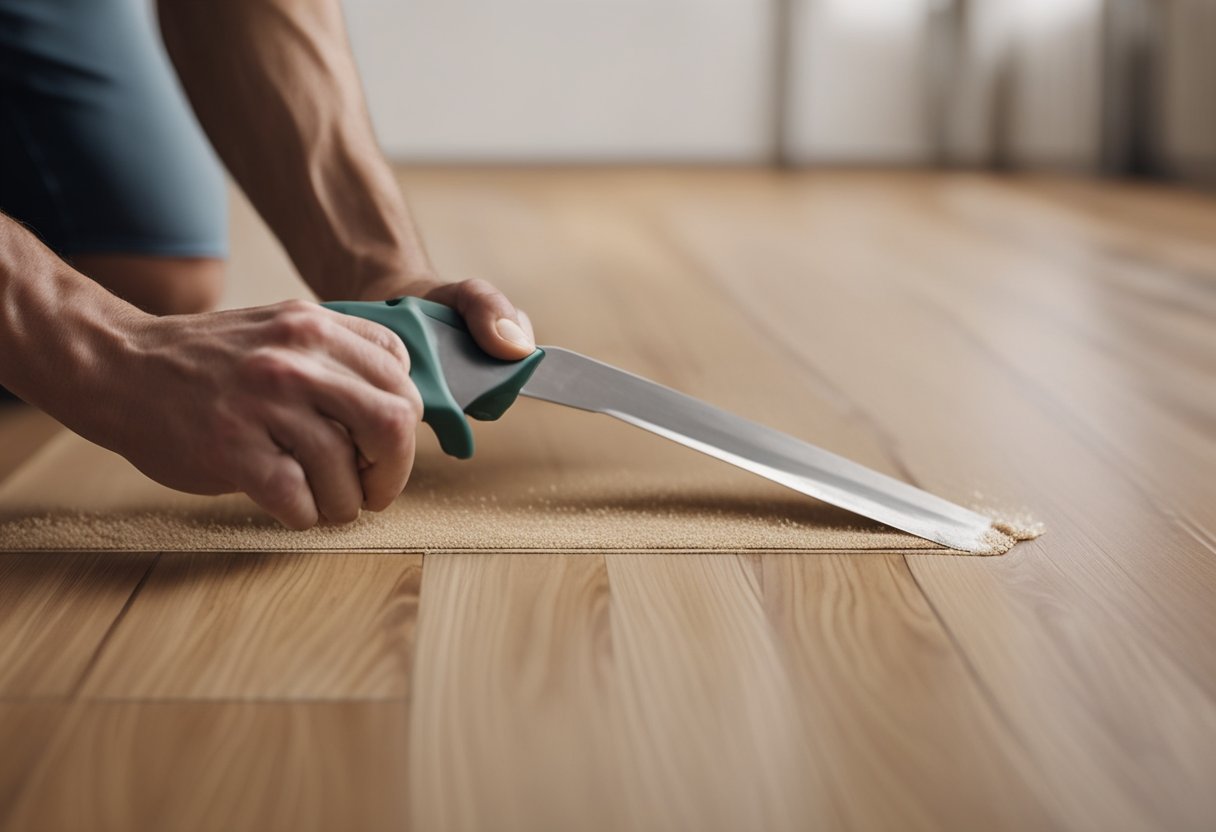
Large gaps in laminate flooring can be caused by a variety of factors, such as improper installation, humidity changes, or wear and tear over time. Fortunately, there are several ways to fix large gaps in laminate flooring. Depending on the cause and size of the gap, you may need to use a combination of methods to achieve the best results.
Key Takeaways
- Large gaps in laminate flooring can be caused by a variety of factors, including improper installation, humidity changes, or wear and tear over time.
- Depending on the cause and size of the gap, there are several ways to fix large gaps in laminate flooring, including using a floor gap fixer tool, replacing damaged planks, or adding a transition strip.
- Preventive measures, such as maintaining proper humidity levels and avoiding excessive moisture, can help prevent gaps from forming in the first place.
Understanding Laminate Flooring Gaps
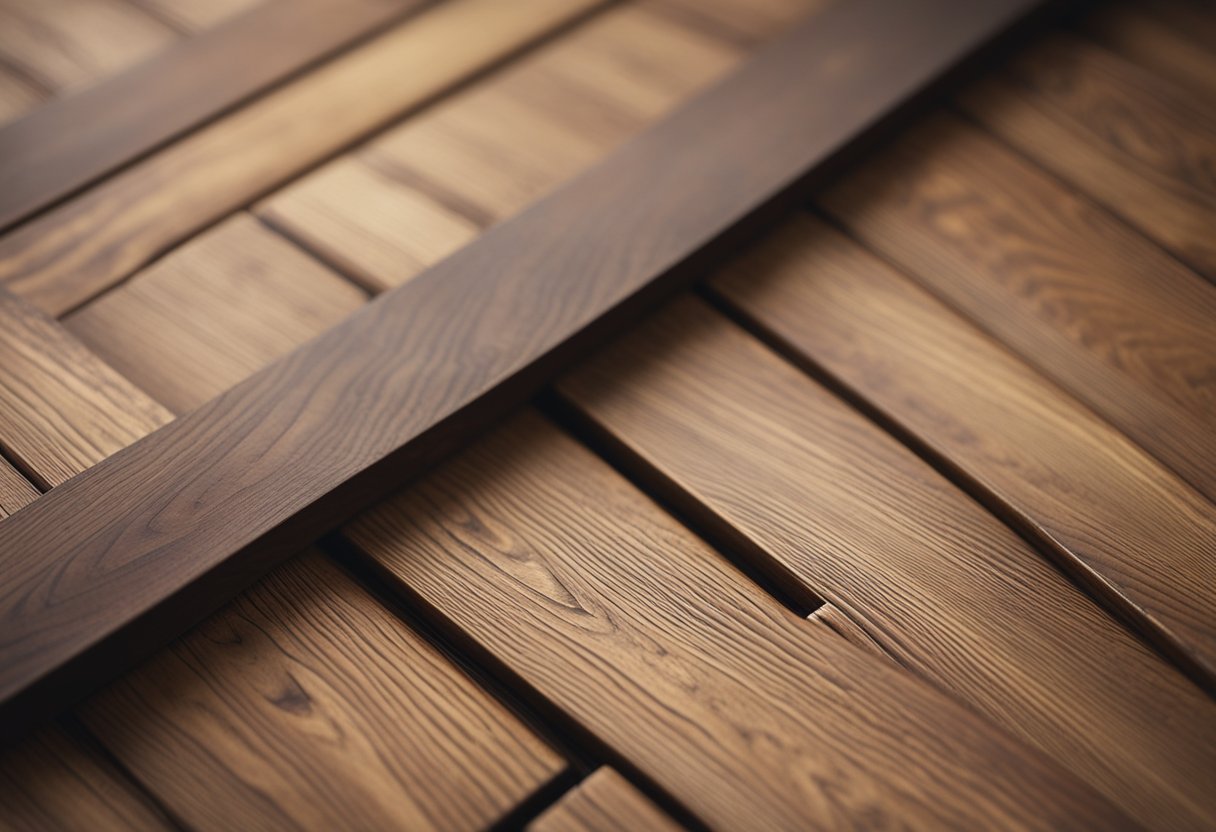
Laminate flooring is a popular choice for homeowners due to its affordability and durability. However, like any flooring material, laminate flooring can develop gaps between the planks. Understanding why these gaps occur can help homeowners prevent them from happening in the first place.
One common reason for gaps in laminate flooring is improper installation. If the planks are not installed tightly enough, gaps can form as the planks expand and contract with changes in temperature and humidity. Additionally, if the subfloor is not level, it can cause the planks to shift and create gaps.
Another reason for gaps in laminate flooring is a lack of expansion gap. An expansion gap is a small space left between the edge of the flooring and the wall to allow for expansion and contraction. If this gap is not present or is not large enough, the planks can buckle or warp, leading to gaps.
Lastly, frequent spills or exposure to moisture can cause the planks to swell and create gaps. It is important to clean up spills promptly and avoid exposing the flooring to excessive moisture.
By understanding the common causes of gaps in laminate flooring, homeowners can take steps to prevent them from occurring. This can include hiring a professional installer, ensuring the subfloor is level, leaving an adequate expansion gap, and avoiding exposure to moisture.
How to Fix Large Gap in Laminate Flooring With Right Tools
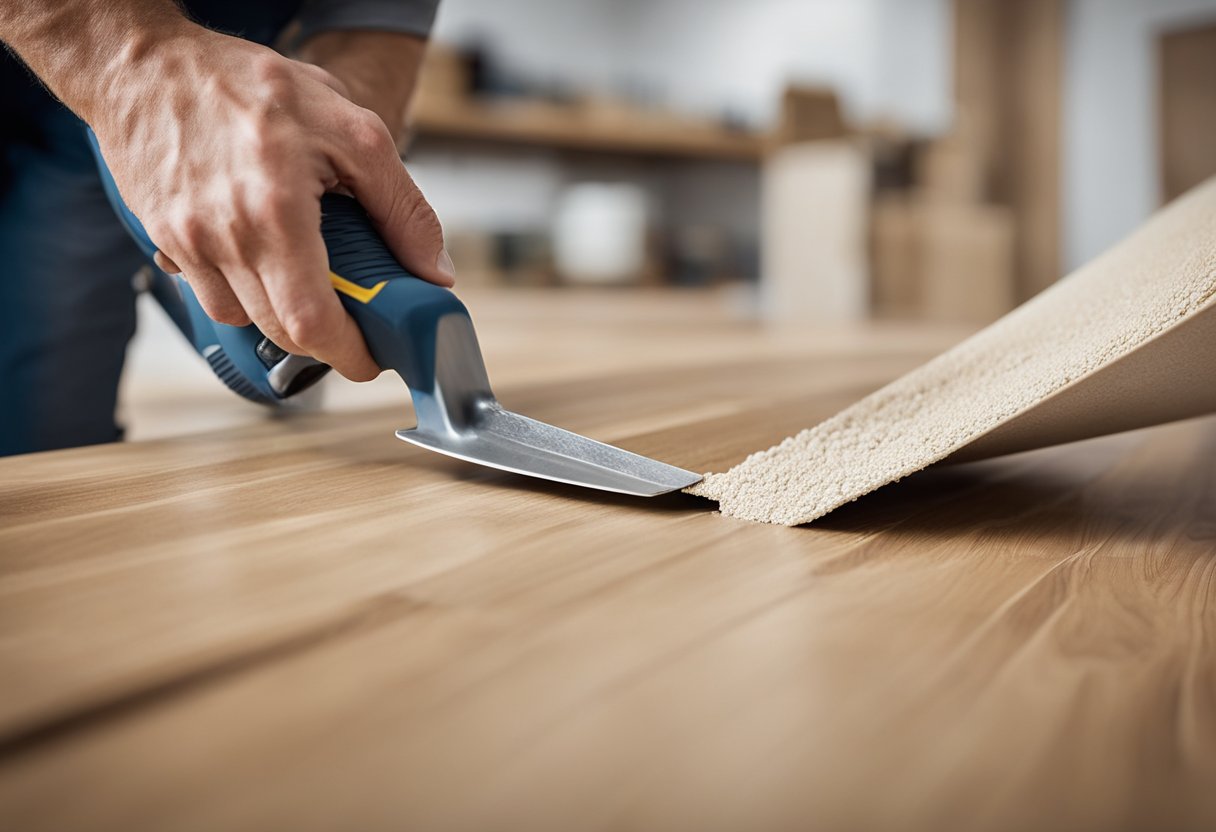
To fix a large gap in laminate flooring, the following tools and materials will be needed:
- Laminate flooring planks
- Measuring tape
- Saw
- Hammer
- Pry bar
- Spacers
- Wood glue
- Caulk
- Finishing nails
Before starting the repair, it is important to measure the gap to determine the size of the replacement plank needed. Once the replacement plank is acquired, the damaged plank can be removed using a saw and pry bar. Care must be taken to avoid damaging the surrounding planks.
After the damaged plank has been removed, the subfloor should be inspected for any damage or unevenness. Any issues with the subfloor should be addressed before installing the replacement plank.
The replacement plank can be installed by using spacers to maintain the proper expansion gap and wood glue to secure the plank in place. Finishing nails can also be used to secure the plank to the subfloor.
Once the replacement plank has been installed, any remaining gaps can be filled with caulk to prevent moisture from seeping into the subfloor. It is important to allow the caulk to dry completely before walking on the repaired area.
How to Fix Large Gap in Laminate Flooring: Preparation Needed

Before repairing a large gap in laminate flooring, it is important to properly prepare the area. The following steps should be taken to ensure a successful repair:
- Clean the area: Remove any debris or dirt from the gap using a soft-bristled brush or vacuum cleaner. This will ensure that the repair material adheres properly to the flooring.
- Measure the gap: Use a ruler or measuring tape to determine the width and depth of the gap. This will help you choose the appropriate repair method and materials.
- Check the humidity: Laminate flooring can expand and contract based on the humidity levels in the room. Make sure the room is at a stable humidity level before attempting to repair the gap.
- Choose the repair method: There are several methods for repairing large gaps in laminate flooring, including removing and replacing planks, adding molding or beading, and caulking. Choose the method that is most appropriate for the size and location of the gap.
By following these steps, you can ensure that your repair will be successful and the gap will be filled properly.
Assessing the Gap Size and Cause
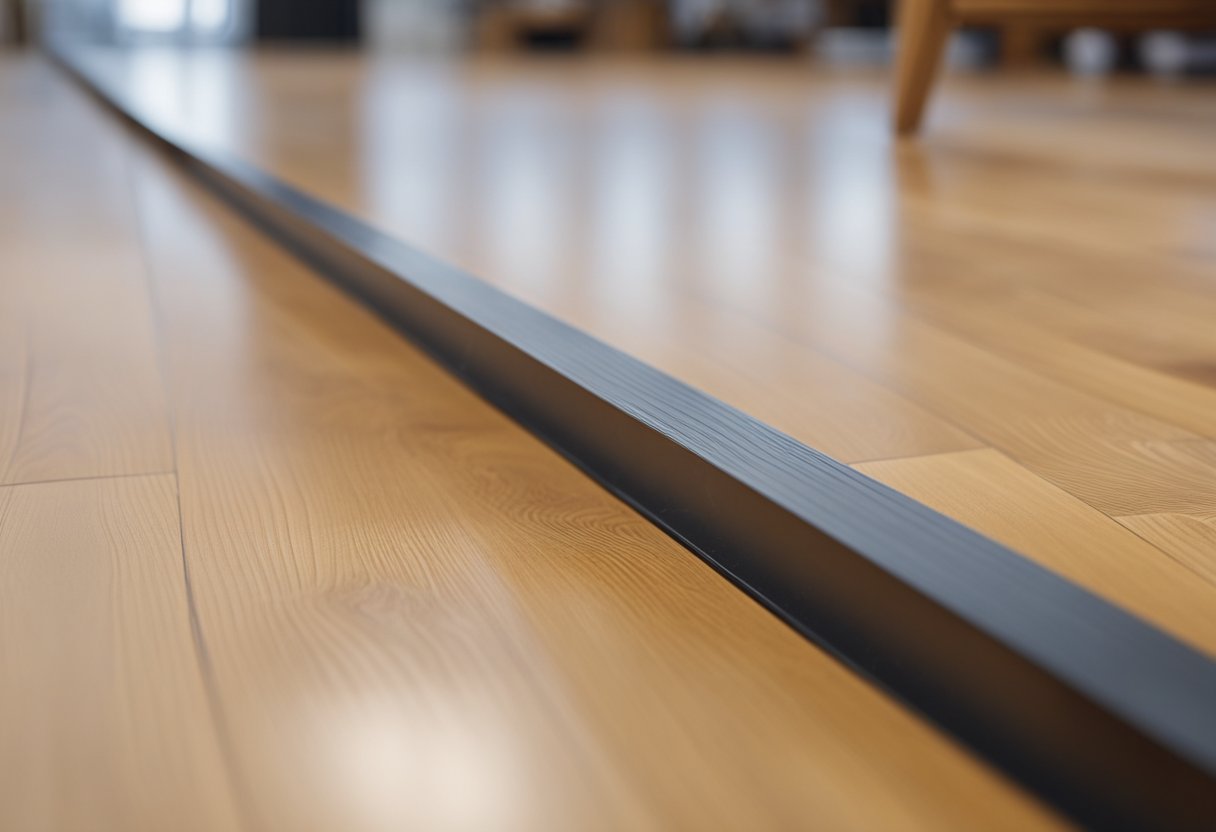
When it comes to fixing large gaps in laminate flooring, the first step is to assess the size and cause of the gap. This will help determine the best course of action for repairing the damage.
One way to assess the gap size is to measure the width of the gap using a ruler or tape measure. If the gap is less than 1/8 inch wide, it may not require any action. However, if the gap is wider than 1/8 inch, it is considered a large gap and should be addressed promptly.
Next, it’s important to determine the cause of the gap. One common cause of large gaps in laminate flooring is improper installation. If the flooring was not installed correctly, it can cause gaps to form over time. Another cause of large gaps is changes in temperature and humidity. Laminate flooring can expand and contract with changes in temperature and humidity, which can cause gaps to form.
It’s also important to assess the location of the gap. If the gap is near a wall or other fixed object, it may be due to the expansion and contraction of the flooring against the object. If the gap is in the middle of the floor, it may be due to improper installation or a problem with the subfloor.
Overall, assessing the size and cause of the gap is an important first step in fixing large gaps in laminate flooring. By understanding the cause of the gap, homeowners can take the appropriate steps to repair the damage and prevent future gaps from forming.
Fixing Small to Medium Gaps
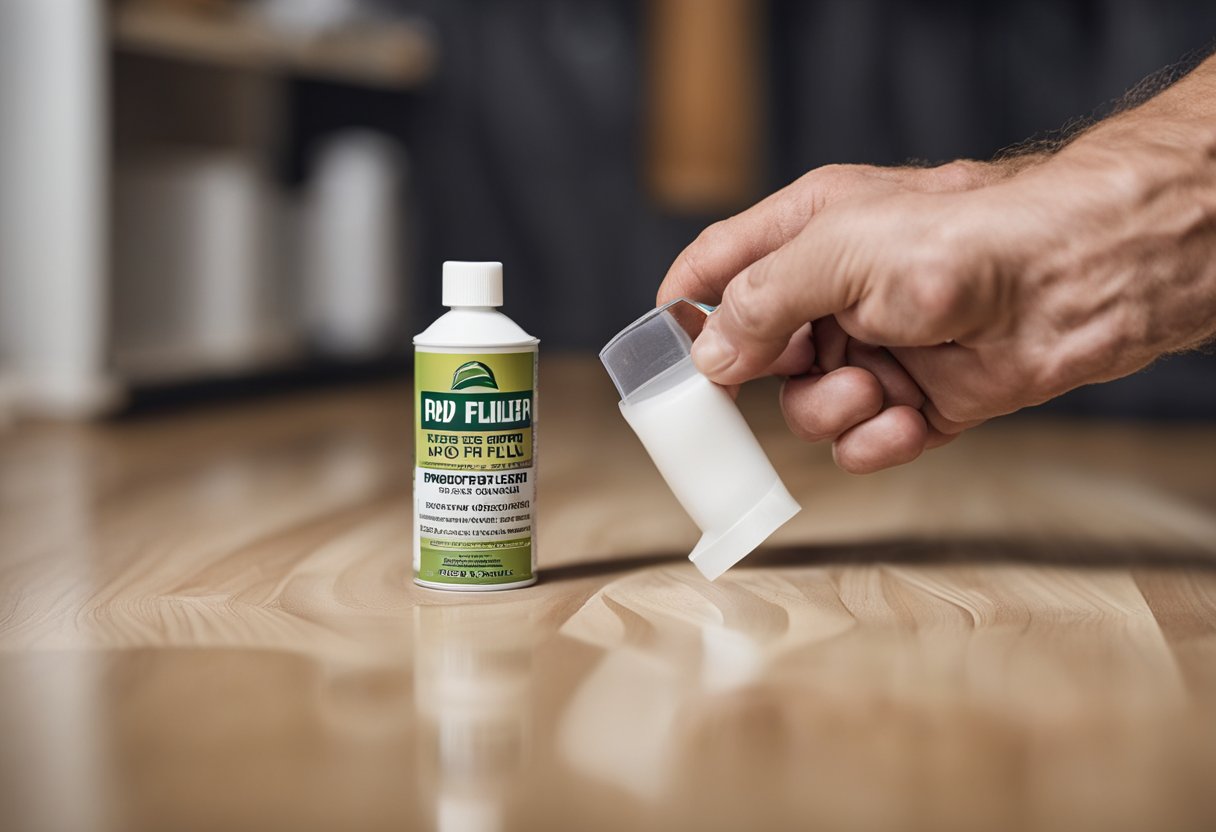
If the gaps in your laminate flooring are small to medium in size, you can fix them yourself with a few simple methods.
Method 1: Replacing Damaged Planks
If the gaps are caused by damaged planks, replacing them is the best option. Follow these steps to replace a damaged plank:
- Remove the baseboard or molding around the damaged plank.
- Use a circular saw to cut the damaged plank down the center.
- Remove the two halves of the damaged plank.
- Measure the length and width of the gap left by the damaged plank.
- Cut a new plank to fit the gap.
- Apply wood glue to the edges of the new plank and insert it into the gap.
- Use a tapping block and hammer to gently tap the new plank into place.
- Reinstall the baseboard or molding around the new plank.
Method 2: Using Wood Putty
If the gaps are caused by normal wear and tear, you can use wood putty to fill them in. Follow these steps to use wood putty:
- Clean the gap with a vacuum or broom to remove any debris.
- Apply wood putty to the gap using a putty knife.
- Use the putty knife to smooth the putty and remove any excess.
- Allow the putty to dry completely.
- Sand the putty with fine-grit sandpaper until it is smooth and flush with the surrounding flooring.
- Clean the area with a vacuum or broom to remove any dust.
By following these simple methods, small to medium gaps in your laminate flooring can be fixed easily and quickly.
Addressing Large Gaps
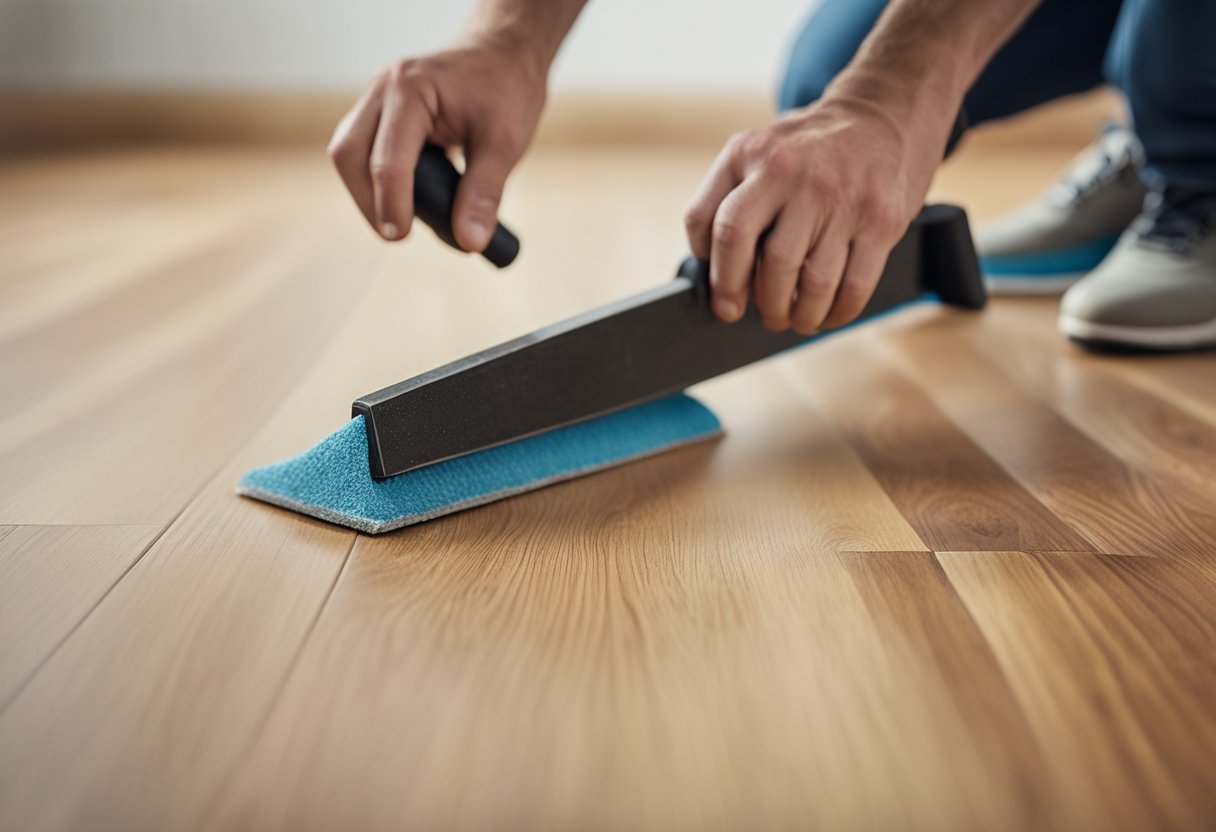
If you have large gaps in your laminate flooring, don’t worry. There are two main methods to address this problem.
Method 1: Flooring Gap Filler
One way to fix large gaps in laminate flooring is to use a flooring gap filler. This is a product specifically designed to fill in gaps between laminate planks. To use this method, follow these steps:
- Clean the gap: Make sure the gap is free of debris and dirt. Use a vacuum or a broom to clean the gap.
- Apply the filler: Apply the filler to the gap using a putty knife or a caulking gun. Make sure to fill the gap completely.
- Smooth out the filler: Use a putty knife or a damp cloth to smooth out the filler. Make sure the filler is level with the rest of the floor.
- Let it dry: Let the filler dry completely before walking on the floor.
Method 2: T-Molding Installation
Another way to fix large gaps in laminate flooring is to install a T-molding. A T-molding is a transition strip that is used to join two different types of flooring together. To use this method, follow these steps:
- Measure the gap: Measure the length and width of the gap.
- Cut the T-molding: Cut the T-molding to the length of the gap using a saw.
- Install the T-molding: Place the T-molding in the gap and secure it using adhesive or nails.
- Finish the edges: Use a laminate trimmer to finish the edges of the T-molding.
By following these methods, you can easily fix large gaps in your laminate flooring.
Preventive Measures for Future Gaps
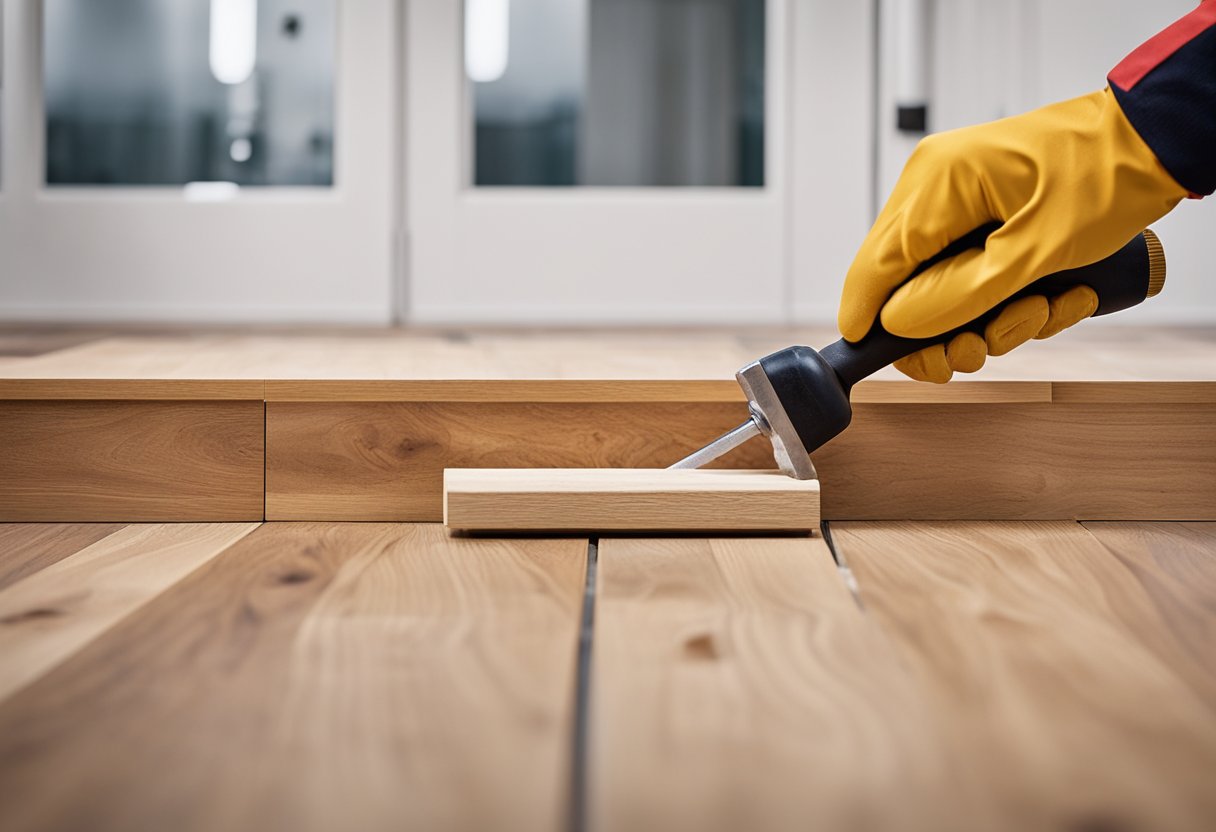
To avoid future gaps in laminate flooring, it is important to take some preventive measures. Here are some tips that can help:
-
Acclimate the flooring: Before installing the laminate flooring, it is important to acclimate it properly. This means that the flooring should be left in the room where it will be installed for at least 48 to 72 hours. This allows the flooring to adjust to the temperature and humidity in the room, reducing the chances of gaps forming later on.
-
Maintain humidity levels: Laminate flooring is sensitive to changes in humidity levels. To prevent gaps from forming, it is important to maintain a consistent humidity level of between 35% and 55%. This can be achieved by using a dehumidifier or humidifier, depending on the climate.
-
Choose the right underlayment: The underlayment is an important part of the laminate flooring installation process. It helps to absorb sound and provide a smooth surface for the flooring. Choosing the right underlayment can help to prevent gaps from forming later on.
-
Install the flooring properly: Proper installation is key to preventing gaps in laminate flooring. Make sure to follow the manufacturer’s instructions carefully and use the right tools for the job. This includes using spacers to maintain the correct expansion gap and tapping blocks to ensure a tight fit between planks.
By following these preventive measures, it is possible to reduce the chances of gaps forming in laminate flooring. However, if gaps do occur, there are ways to fix them, as discussed in the previous section.
Finishing Touches and Cleaning
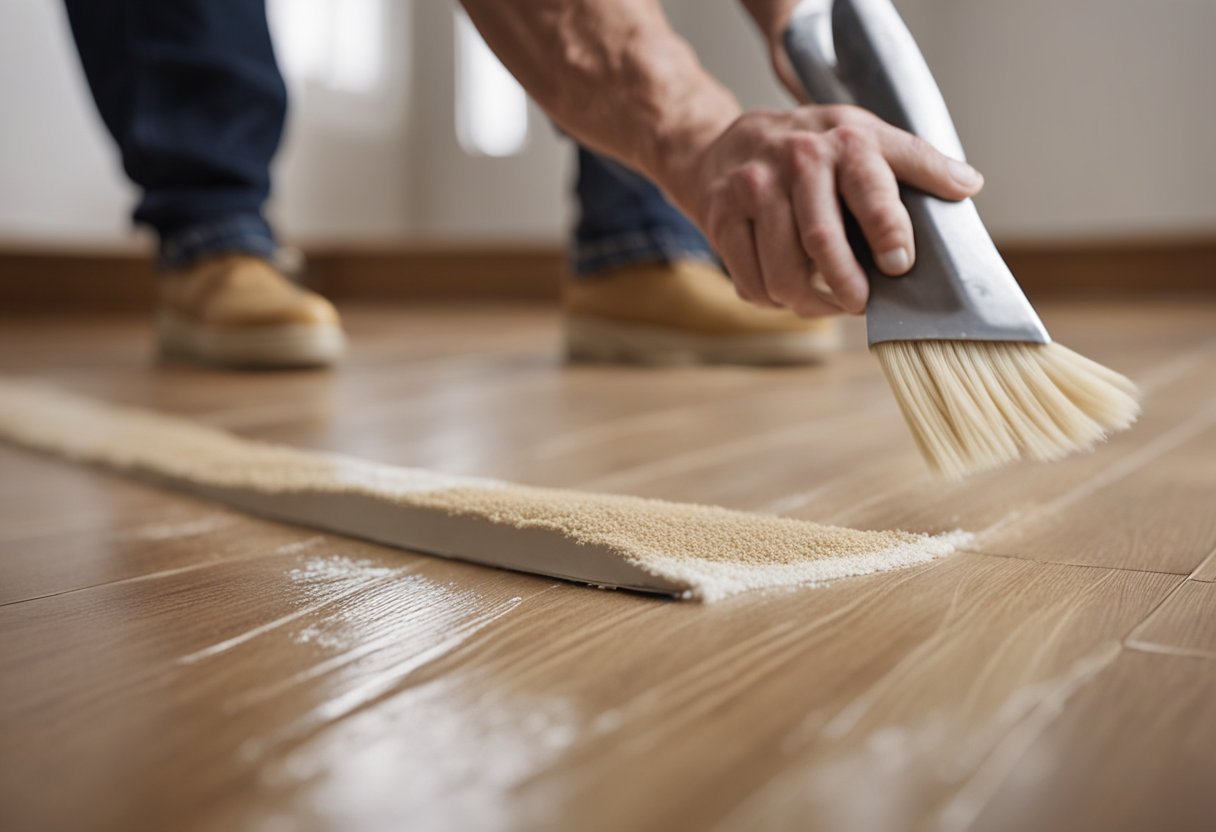
Once the gaps in the laminate flooring have been fixed, it’s time to add the finishing touches. First, make sure to remove any excess glue or filler that may have seeped out during the repair process. A plastic scraper or putty knife can be used to gently scrape away any excess material.
Next, clean the entire floor with a damp mop and a mild cleaning solution. Avoid using harsh chemicals or abrasive scrubbers, as they can damage the surface of the laminate. Instead, use a soft cloth or mop and a solution of warm water and a mild detergent.
After cleaning, it’s important to maintain the floor properly to prevent future gaps from forming. One way to do this is to maintain a consistent temperature and humidity level in the room. Laminate flooring can expand and contract with changes in temperature and humidity, so keeping the environment stable can help prevent gaps from forming.
Another way to prevent gaps is to avoid dragging heavy furniture or appliances across the floor. This can cause the planks to shift and create gaps. Instead, use furniture pads or sliders to move heavy objects.
Finally, it’s important to clean up spills and stains as soon as possible. Laminate flooring is resistant to stains, but if a spill is left sitting for too long, it can seep into the gaps and cause damage. Clean up spills with a damp cloth and a mild cleaning solution as soon as possible to prevent this from happening.
Professional Repair vs. DIY
When it comes to fixing a large gap in laminate flooring, homeowners have two options: professional repair or DIY. Both options have their pros and cons, and the decision ultimately depends on the homeowner’s skill level, budget, and time constraints.
Professional Repair
Hiring a professional to fix a large gap in laminate flooring can be the best option for those who lack the necessary tools or experience to do the job themselves. Professionals have access to specialized equipment and materials, and they can quickly and efficiently fix the problem without causing further damage to the flooring.
However, professional repair can be expensive, and the cost can vary depending on the severity of the problem and the location of the home. Homeowners should also do their research to find a reputable and experienced professional to ensure that the job is done correctly.
DIY
Fixing a large gap in laminate flooring can be a DIY project for those who are handy and have the necessary tools. DIY repair can save homeowners money and give them a sense of satisfaction from completing the project themselves.
However, DIY repair can also be time-consuming, especially for those who are not experienced. Homeowners should also be aware that if the repair is not done correctly, it can cause further damage to the flooring, which can be costly to fix.
In conclusion, both professional repair and DIY have their advantages and disadvantages when it comes to fixing a large gap in laminate flooring. Homeowners should carefully consider their skill level, budget, and time constraints before deciding which option is best for them.
Maintenance Tips After Repair
After fixing the large gaps in your laminate flooring, it is important to take proper care of it to prevent future damage. Here are some maintenance tips to follow:
- Regularly clean the floor with a soft-bristled broom or vacuum cleaner to remove dirt and debris. Avoid using harsh chemicals or abrasive cleaners that can damage the surface of the laminate.
- Place protective pads under furniture legs to prevent scratches and dents. Avoid dragging heavy furniture across the floor as it can cause damage.
- Wipe up spills immediately with a clean, damp cloth to prevent moisture from seeping into the gaps and causing further damage.
- Use a humidifier in dry climates or during the winter months to prevent the laminate from drying out and cracking.
- Avoid exposing the laminate to direct sunlight for extended periods of time as it can cause fading and discoloration.
By following these maintenance tips, you can help prolong the life of your laminate flooring and prevent the need for future repairs.
Troubleshooting Common Issues
Laminate flooring is a popular choice for many homeowners due to its affordability and durability.
However, even with proper installation, gaps may still appear over time.
Here are some common issues that may cause gaps in laminate flooring and also discover how to fix large gap in laminate flooring by yourself.
1. Temperature and Humidity
Temperature and humidity levels can affect the size of gaps in laminate flooring. If the room is too dry, the planks may shrink, leaving gaps between them. Conversely, if the room is too humid, the planks may expand, causing the gaps to close up. To fix this issue, homeowners should maintain a consistent temperature and humidity level in the room. A humidifier or dehumidifier can help regulate the moisture levels in the air.
2. Improper Installation
If the laminate flooring was not installed correctly, gaps may appear between the planks. Homeowners should ensure that the subfloor is level and free of any debris before laying down the laminate planks. Additionally, they should follow the manufacturer’s instructions carefully, including leaving the recommended expansion gap around the perimeter of the room. If the gaps are due to improper installation, homeowners may need to hire a professional to fix the issue.
3. Subfloor Issues
Uneven subfloors can cause gaps to appear in laminate flooring. Homeowners should ensure that the subfloor is level before installing the laminate planks. If the subfloor is uneven, they may need to use a self-leveling compound to even it out before laying down the laminate planks.
4. Wear and Tear
Over time, laminate flooring may experience wear and tear, causing gaps to appear between the planks. Homeowners can fix this issue by replacing the damaged planks. They should ensure that the new planks match the existing flooring in terms of color, style, and thickness.
By troubleshooting these common issues, homeowners can fix large gaps in laminate flooring and ensure that their flooring looks as good as new.
FAQ on How to Fix Large Gap in Laminate Flooring
What methods can be used to close gaps in laminate flooring?
There are several methods to close gaps in laminate flooring. One of the easiest ways is to use a floor gap fixer tool. This tool works by compressing the planks together and closing the gaps. Another method is to use wood glue to fill the gaps. This method requires patience and precision, as excess glue can damage the laminate flooring.
Can wood filler be used to address gaps in laminate flooring?
Wood filler is not recommended to address gaps in laminate flooring. This is because wood filler is not flexible and can crack or break when the laminate flooring expands or contracts due to changes in temperature or humidity.
What are the steps to fix separation in laminate flooring on the long side?
To fix separation in laminate flooring on the long side, first remove the baseboard molding. Then, use a pull bar and hammer to tap the planks back into place. If the gap is still visible, use a floor gap fixer tool or wood glue to close the gap. Finally, replace the baseboard molding.
Is it possible to seal gaps in laminate flooring using caulk?
Sealing gaps in laminate flooring using caulk is not recommended. Caulk is not flexible and can crack or break when the laminate flooring expands or contracts due to changes in temperature or humidity.
How can I repair poorly installed laminate flooring that has developed gaps?
If your laminate flooring was poorly installed and has developed gaps, it may be necessary to remove and reinstall the affected planks. This can be a time-consuming and costly process, but it is the only way to ensure that the gaps are properly addressed.
Can duct tape be effectively used to bridge gaps in laminate flooring?
Duct tape is not recommended to bridge gaps in laminate flooring. Duct tape is not designed for use with flooring and can leave a sticky residue that is difficult to remove. Additionally, duct tape is not flexible and can crack or break when the laminate flooring expands or contracts due to changes in temperature or humidity.
Final Word
In conclusion, how to fix large gap in laminate flooring requires a blend of proper assessment, the right tools, and a strategic approach tailored to the specific cause and size of the gap.
Whether you opt for DIY methods like using a floor gap fixer tool, replacing damaged planks, or adding a transition strip, or decide to seek professional help, the key is to act promptly and effectively.
By also focusing on preventive measures such as maintaining proper humidity levels and ensuring correct installation practices, you can safeguard your laminate flooring against future gaps, ensuring its longevity and aesthetic appeal.